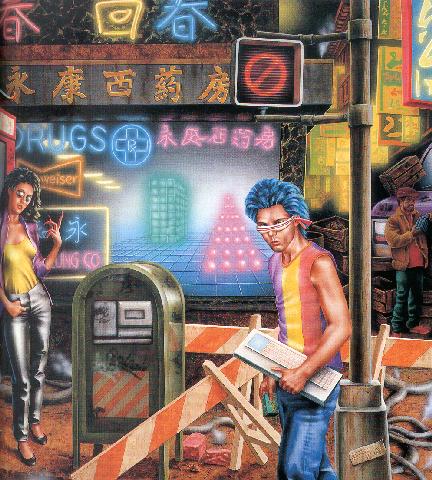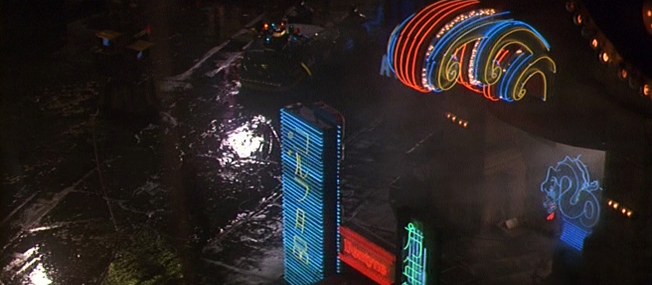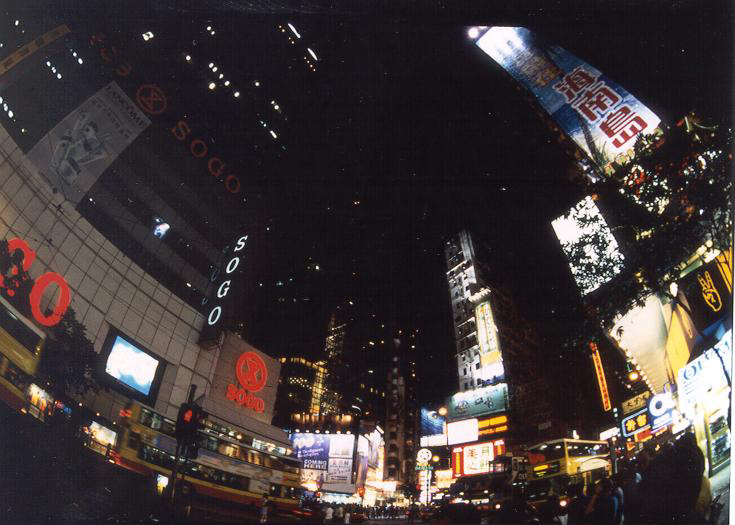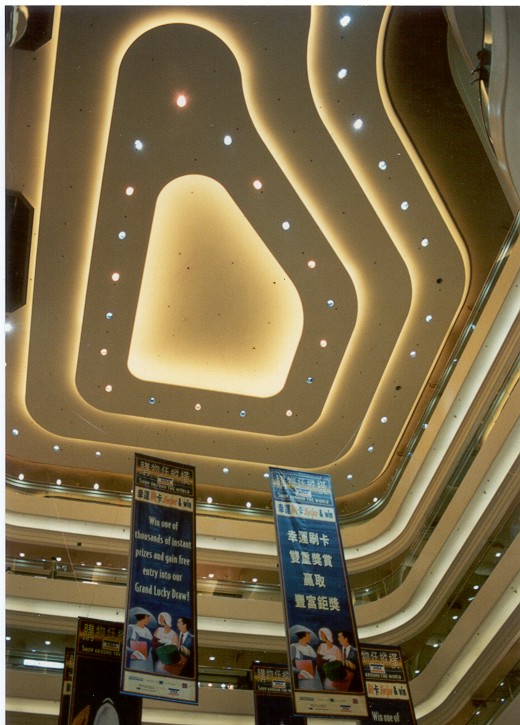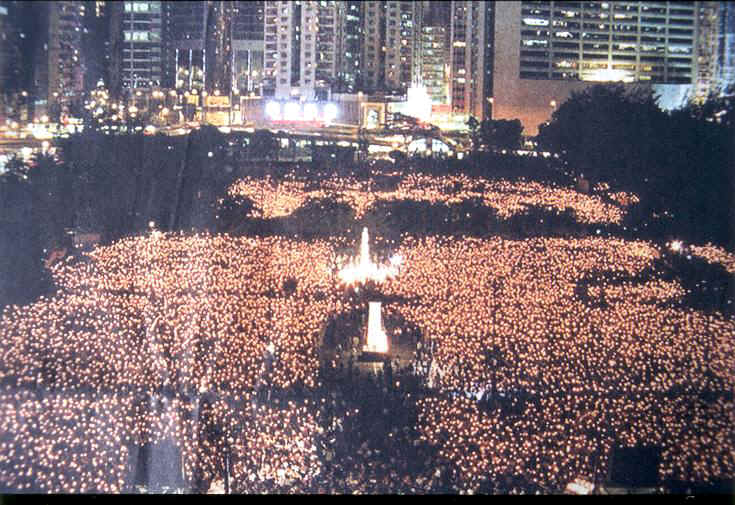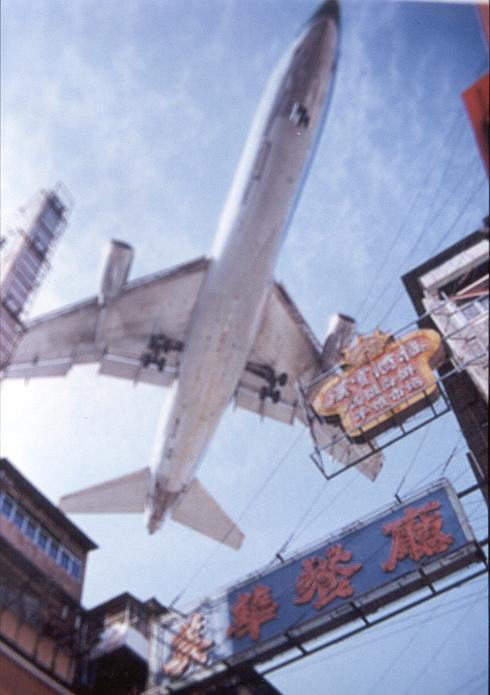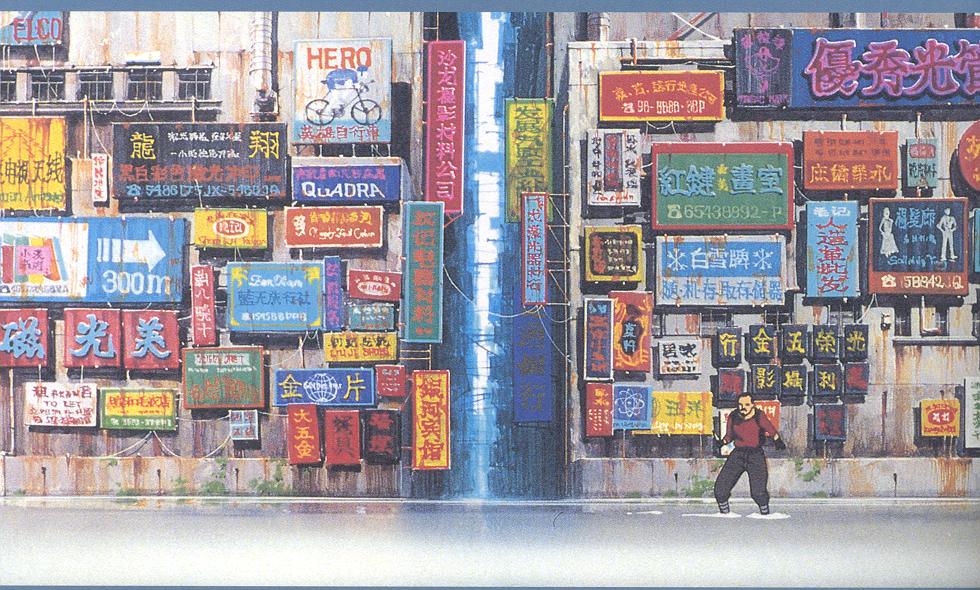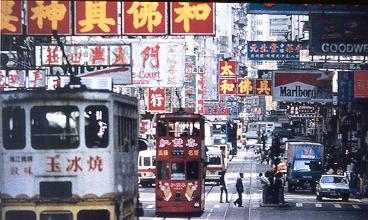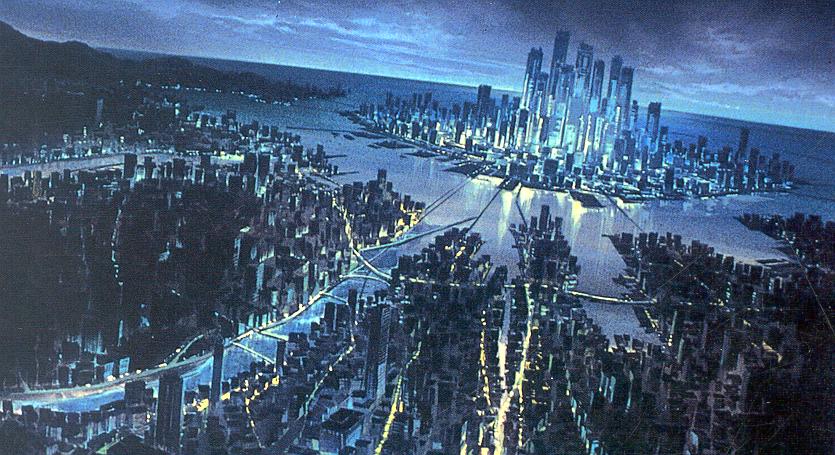#80 = Volume 27, Part 1 = March 2000
Wong Kin Yuen
On the Edge of Spaces: Blade Runner, Ghost in the Shell , and Hong Kong's Cityscape
Colonial cities can be viewed as the forerunners of what the contemporary capitalist world city would eventually become. For ... in the colonial and paracolonial societies and especially Asia, Africa and Latin America ... the representatives and institutions of industrial capitalism first confronted those of ethnically, racially, and culturally different pre-industrial and pre-capitalist societies at any significant scale. -- Anthony King, Global Cities (38)
The gigantic mass is immobilized before the eyes. It is transformed into a texturology in which extremes coincide -- extremes of ambition and degradation, brutal oppositions of races and styles, contrasts between yesterday's buildings, already transformed into trash cans, and today's urban irruptions that block out its space.... Its present invents itself, from hour to hour, in the act of throwing away its previous accomplishments and challenging the future. -- Michel de Certeau, "Walking in the City" (152)
1. It is now widely acknowledged that Ridley Scott's Blade Runner (1982/ 1992) initiated a whole tradition of cult movies later grouped under the label "cyberpunk." Blade Runner's style draws its images from urban spaces all over the world, including such Asian cities as Tokyo and Hong Kong. Science fiction film critics are less aware, however, that when anime film director Mamoru Oshii was looking for a model of the city of the future in a computerized world, he turned for his primary inspiration to the cityscape of Hong Kong. Through his art designers, actual spots in the city of Hong Kong were transformed into the mise-en-scène of Ghost in the Shell, first released in the United States in March 1996.
Science fiction has not fared well in Hong Kong (either in terms of production or consumption), nor is there a cyberpunk culture among Hong Kong's young computer users. So the question arises: what elements in Hong Kong provided inspiration for this cinematic representation of a near-future city characterized by decadence, anarchy, and fantasy on the one hand, and a mistrusted, high-tech hyper-reality on the other? Taking up this question, I will first suggest a reading of a shopping complex in Hong Kong that emphasizes its fragmentation, disjunctiveness, and ephemerality. Like Blade Runner's "Ridleyville," this Hong Kong shopping complex intertwines past and future, memory and desire. Finally, I will analyze the setting of Ghost in the Shell, especially the parts that are clearly modeled on Hong Kong street scenes and architecture. I hope to validate Anthony King's argument that colonial cities have the best chance of establishing a cityscape of the future that embraces racial and cultural differences.
Before going any further, let me address the politics of representation, especially in the visual media of cyberpunk art and films. Following the success of Blade Runner, such cyber-thrillers as Johnny Mnemonic (1995), Hackers (1995), Lawnmower Man 2 (1996), and Strange Days (1995) have also selectively used motifs of "Asian" design environments, together with their visual icons, to portray cultural difference and to create visual pleasure from postmodern pastiche. As in Blade Runner, the most popular model for artists' and filmmakers' dark and sprawling cities of the future is an Asian-dominated metropolis. Cyberpunk novels, including Gibson's Neuromancer (1984) and Stephenson's Snow Crash (1992), likewise emphasize Asian culture and urban style, suggesting (as John Christie has argued) "the replacement of the hegemonic state apparatus by multinationals, its cultural pluralism" (173). Whereas Snow Crash's "Mr. Lee's Greater Hong Kong" is set in cyberspace, Neuromancer's Night City, The Sprawl, coffin hotel, and Ninsei are based on the Tokyo Bay area. In his recent novel, Idoru (1996), Gibson even presents organic buildings in a 21st-century Tokyo. (In this case, there must also be some connection to Hong Kong as well, since in his acknowledgment to a Japanese director, Gibson mentions "Kowloon Walled City," which has "continued to haunt him" [n.pag.] ever since the latter told him about it.)
For sf illustrator Barclay Shaw, the merging of cyberspace with the sleazy, neon-lit visual passion in Neuromancer closely resembles a chaotic Hong Kong street. Commissioned as cover art for the 1986 Phantasia Press edition of the novel, the painting chooses some Chinese characters (presumably taken from Hong Kong shop signs) for the foreground, highlighting not only a sense of ethnic and cultural confusion and hybridity but also a continuous process of the destructions and reconstructions so characteristic of contemporary cityscapes. This is certainly in line with the cyberpunk convention of "the run-down inner-city slum-cum-tent settlement, overcrowded, trashed and graffiti-ridden" (Bonner 194), reminding us at the same time of Blade Runner's Ridleyville.
We also find visual icons relating to Chinese characters, obviously within a "Chinatown" setting, in cyberpunk films such as Strange Days. Set in Los Angeles a few days shy of the millennium, the film sustains film noir tradition through dark and explosive scenes of riots and chaos. In between these hybridized sites and battle zones on the streets, Chinatown's glittering lanterns (not the authentic kind with real candlelight, of course), together with the profusion of shops and commercial sign boards characteristic of a normal busy Hong Kong street, juxtapose visual alternatives and establish a tone somewhere between eroticism and dreariness. This kind of design, which marks the unmistakable miscellaneity of a metropolis, suggests a near future where centers and peripheries do not hold and where racial conflicts are at the point of explosion; it also provides an appropriate way to exhibit an "inverted millennarianism" (Jameson 53). Scenes from a kitchen in a Chinese restaurant depict violence and intrigues played out among individuals, while collective racial protests and riots are taking place in the streets. It is curious that such "Chinese" vignettes have become a favorite among recent Hollywood filmmakers. Compared to the front of the restaurant in Strange Days, where decor and orderliness prevail, the kitchen is filmed as a clandestine negative space signifying hiddenness and disorder. In the restaurant kitchen, the flawed character Nero plays out his drama of fighting back against corporate crimes, providing a contrast with the public atrocities committed in front of millions of people during the New Year countdown celebration at the movie's conclusion.
In Strange Days, "Chinese" spaces are represented as hidden within the context of the future urban setting. Is there any cultural or ideological significance in this -- beyond the fact that a Chinese restaurant kitchen is an exotic spot? Does this added element of Chineseness (contrasted with the exploding warfare among races and social classes in Strange Days) help to bring out the theme of the intertwining relations between social space and media space? Finally, since Chinatown settings are spaces famous for being inhabited by illegal immigrants, we will need to follow Homi Bhabha's critique of the "metropolitan histories" of the west, "the anomalous and discriminatory legal and cultural status assigned to migrant, diasporic, and refugee populations" who "find themselves on the frontiers between cultures and nations, often on the other side of the law" (Bhabha 175).
2. We must be careful, however, in interpreting the ways the Hong Kong cityscape is appropriated by cyberpunk literature and films; we must remember that Hollywood has had a long history of misrepresenting Hong Kong, from white-male fantasies about oriental girls (The World of Suzy Wong [1961]) to exploitative soft-core pornographic eroticism (the Emmanuelle films). More recently, a quick shot in the low-budget Lawnmower Man 2 shows a yellow rickshaw pulled by a Chinese man on the street of yet another Los Angeles of the future. An offensive example of "non-equivalent sites of representation" (Bhabha 176), this rickshaw scene exemplifies a brutal seizure of a cultural sign by the west, a way of "evoking ... savage colonial antecedents" for the sake of presumed "ideals of civility" (Bhabha 175).1 Whether cyberpunk film directors are themselves free from this mire of distortion in their renderings of Hong Kong's urban images is of course an important question to ask here.
Blade Runner's cultural references are indirect, yet I propose to compare the design of the film's city setting with an actual spot in Hong Kong that may provide a paradigm for future global cities. The incredibly detailed Los Angeles of 2019 in Blade Runner creates a futuristic noir atmosphere by heavily borrowing from Asian motifs, albeit vague and general ones, in its design of city icons and social spaces. With the artful "retro-fitting" and "layering" of the Japanese sushi bar, the gigantic media screen of the geisha girl ad, and a Chinese bio-engineer who "only does eyes," the city, critics are quick to point out, looks like "Chinatown in Tomorrowland" (Hunter 225); the sleazy cinematography results in a hybrid and fractal combination of "Hong Kong, New York, [and] Tokyo's Ginza district" (Sammon 101). I would argue that considering Hong Kong as among the cinematic models for the future city may inspire not only a further look at Hong Kong at this present moment of political transition but also its potential for developing into a "forerunner of what the contemporary capitalist world city will eventually become" (King 38).
Perhaps because of its recent reabsorption by China, Hong Kong has drawn enormous interest from urban scholars and social critics. Struggling historically between traditional Chinese culture and British imperialism, and at this moment adjusting its full-fledged capitalism in order to be embraced by socialism, Hong Kong's postmodern identity has been singled out as a unique case in the world, characterized by "disappearance" and "hyphenation" (Abbas 1994; 1996) or dealt with in terms of "discourses in collision under the volcano" (Cuthbert 1995).
As someone who grew up in Hong Kong, I am particularly fascinated by the dazzling visuals of Blade Runner's Ridleyville, its seamless weaving together of the futuristic and the traditional, as well as its paradoxical delighting of the eye through an emphasis on urban squalor. Other aspects -- hybrid architectural spaces, crowdedness, the polyglot or mishmash city-speak, the chaotic proliferation of neon billboards above futuristic shopping arcades, the rain-soaked streets and dragon signs -- invite me to conclude that this Los Angeles of 2019 can indeed be read as "Hong Kong on a bad day" (Salisbury 96; Doel and Clarke 163).
The questions remain to be asked: what illumination does Blade Runner offer us for envisioning the 21st century cityscape, and what role will Hong Kong play in shaping our expectations of the city of the future? This film's "radical eclecticism or ad hoc-ism" (Bruno 66) catches my eye and inspires me to think about the evolving scenes of my own city, freeing me from clichés (Hong Kong is a dynamic and international city with post-industrial and postmodernist characteristics, etc.). Let me go right to a specific Hong Kong space for a detailed description, to demonstrate the value of placing Ridleyville and Hong Kong together.
The place is located at the juncture of Happy Valley and Causeway Bay around Russell Street and Sharp East Street, one of the most densely populated areas of Hong Kong. Perhaps no other place can demonstrate so well the strange mix of global and local in truly cosmopolitan downtown development. The space occupies half a square mile of streets, shops, flyovers, and the recent addition of a mall, "Times Square." It is certainly an "urban secret located at the intersection of postmodern and science fiction" (Bukatman 12).
Apparently no parody was intended by naming the place after New York's Times Square, but the name does reflect and even reaffirm its own historicity and timeliness -- albeit the kind of schizophrenic temporality that Fredric Jameson uses in his famous reading of the Bonaventure Hotel (80-85). The complex itself, built on top of a busy metro station, stretches from several levels underground to skyscraper height, looking down on the adjacent, much older buildings, "indifferent to its surrounding" (Abbas 1996, 221). For city-planners, especially visitors, the awkward and abrupt sense of discrepancies on all levels is impossible to miss. The complex was built on a former tram-depot skirted by an old-style street market and the quarters for lower echelon tram-company employees. Thus an area once inhabited by comparatively low-income locals has been transformed by commercialism into a high-tech wonder, a bewildering collage of signs and patterns with enough anarchic elements remaining (a small part of the market and old style shops) to create a sense of pastiche. Yet nothing unusual or uncanny is felt by the people who live there; and in general the logic of capitalism, in which "shopping is an aesthetic experience" (Webster 212), works beautifully, since the spot has become (with its advantages of proximity and diversity, its availability and variety of consumer goods) one of the busiest and most prosperous places in Hong Kong.

But who are these inhabitants? They are shoppers, blue- and white-collar workers, tourists of all nationalities, and an ever-changing population of new immigrants (some of them illegal), working mostly in the old shops. The people of "Times Square" are both rich and poor, young and old. More than Disneyland, this phoenix in the rubble is patronized by practically all walks of life; and this absolute accessibility to the fairyland of diversity and display accounts for its success. This is of course the exact opposite of the kind of cityscape deliberately designed "to wall off the differences between people, assuming that these differences are more likely to be mutually threatening than mutually stimulating" (Sennet xii). To walk in this area is to float with, through, and against the crowd, always on one's way to somewhere else. This may well be an indication of a degree of pedestrian movement and flow unique to Hong Kong. Arjun Appadurai's comments on the landscape of people (as constituting this shifting world of ours) is particularly pertinent to description of Hong Kong's Times Square:
[T]ourists, immigrants, refugees, exiles, guestworkers and other moving groups and persons constitute an essential feature of the world and appear to affect the politics of (and between) nations to a hitherto unprecedented degree. This is not to say that there are no relatively stable communities and networks, of kinship, of friendship, of work and of leisure, as well as of birth, residence and other filiative forms. But it is to say that the warp of these stabilities is everywhere shot through with the woof of human motion, as more persons and groups deal with the realities of having to move or the fantasies of wanting to move. (7)
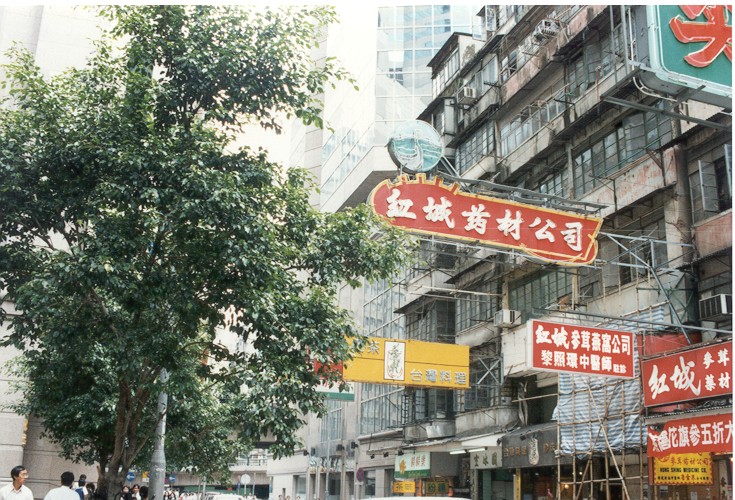
This postmodern architectural environment in Asian cities may have been the source of their fascination for cyberpunk film designers. I doubt that Ridley Scott knew of the existence of the Hong Kong Times Square when he was conjuring up his Los Angeles set in Blade Runner, but I would like to juxtapose an early sketch of his with a couple of photos for comparison. What first catches the eye, besides striking resemblances in the busy streets, the futuristic shopping arcades, the neon-lit billboards, the garbage, the drunkards, and so on, is the huge 9 x 6 meter video screen acting almost as the backdrop, an immense icon of power. This gigantic screen hanging above busy streets in future cities has been a common and almost indispensable motif among cyberpunk films. From Running Man (1987) to Johnny Mnemonic and Hackers to Strange Days, this screen has become the hallmark of postmodern cities, a mirror of information networks, an entrance into cyberspace. Scott's screen is later changed into an even bigger one showing a close-up of an alluring Japanese geisha who is always trying to sell something, set in contrast with a flying blimp beaming with flashing lights to advertise off-world immigration. At Hong Kong's Times Square, however, the screen shows more than animated advertisements: since it is also connected to the cable TV channels, it broadcasts local and international news to passers-by. Indeed, for several months the cable TV channels have presented a live talk show on the square below the screen: hyperreality in its extreme comes into reality.
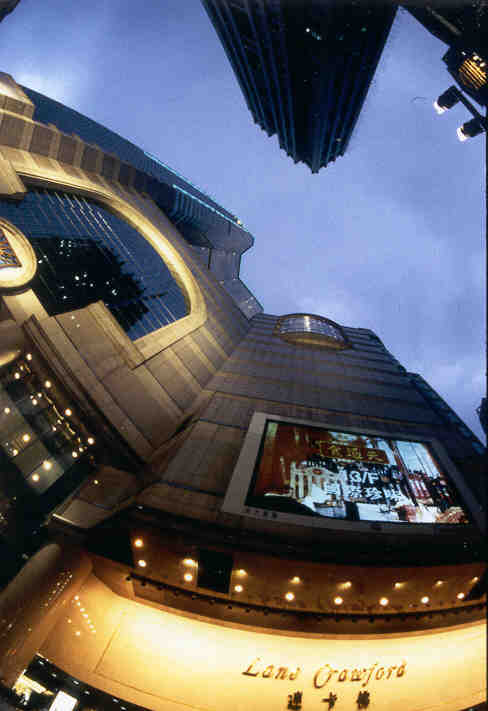
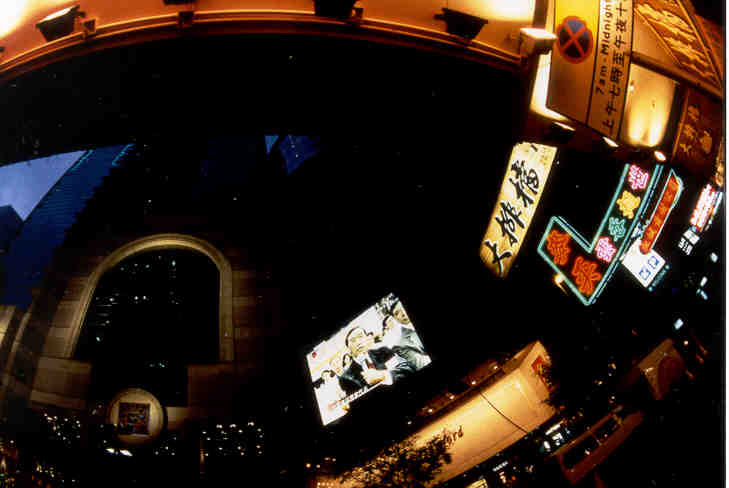
Much has been said about the relationship between cyberpunk culture and our so-called post-information age. Theoretical studies such as Debord's Society of the Spectacle and Bukatman's Terminal Identity have illuminated the significance of such a gigantic screen as an alternative space of the visual. Starting from the Lacanian concept of subject-formation through the image in a mirror, critics have noticed that with the advent of optical technology, this mirror is turned into, say, the video camera, which does the work of at once creating, reflecting, and distorting the image of the self. All city dwellers, especially regular shoppers in modern malls, have had the experience of walking by a camera shop, leisurely looking, and then suddenly seeing their own image also walking by and looking on but from the opposite direction and angle. They then realize that this is the video camera set to automatic and placed behind the shop window, shooting outward.
Edward Soja has explained how some critics provide insights "on how fragmentation, ruptures, deviation, displacements, and discontinuities can be politically transformed from liability and weakness to a potential source of opportunity and strength." He describes how the feminist critic Anne Friedberg, during her "window shopping" in Paris, focuses on those "machines of virtual transport" that "break us out of our constraining spatio-temporal containers, starting with the panorama and the diorama and ending with the 'virtual tourism' provided by cinema and its extensions, most notably the television and the VCR" (Soja 117). In this context, the activities surrounding the screen on the square can be considered an extreme enlargement of the automatic video camera experience just mentioned.
Incidentally, there is at least one camera shop on one of the levels in the Times Square complex that does film the passers-by. I would suggest, following Baudrillard's assertion, that we are the first generation who actually live in science fiction: such experiences have become sf experiences, or even cyberpunk experiences.
3. At this point, a more careful reading of the differences in the architectural layout of Blade Runner and Times Square in Hong Kong is called for. Unlike Scott's near-future Los Angeles, Hong Kong is not disintegrating or in ruins. Yes, there is a lot of garbage on the streets; but it is not technological waste or post-industrial decay, at least not the "height of exhibition and recycling" (Bruno 64). In addition, whereas the postmodern, hybridized, mismatched architectural styles in Blade Runner convey banality by an uneasy combination of pastiche quotations (Chinese-dragon characters and Egyptian decor in a Mayan pyramid), in Hong Kong's Times Square, the extravaganza of hybridity only reflects a grotesque piecing together of disparate times and styles -- the temporality of architectural efforts. Instead of Sebastian's and Deckard's nearly empty 97th-floor apartments overlooking the deserted city, what we can see, through the glass-encased escalator from the mall, are shattered flats occupied by poor people. Yet although these are run-down buildings, they are not deserted and soon they will be pulled down to make space for new ones.
Besides, Blade Runner emphasizes the likely explosion of the Asian population of Los Angeles in the 21st century. Such domination by Asian elements contributes to the film's emphasis on an "explosion of urbanization, melting the futuristic high-tech look into an intercultural scenario, recreat[ing] the third world inside the first" (Bruno 66). How can this Los Angeles-becoming-Chinatown be put alongside the transformation of Hong Kong's urban spaces? While these discrepancies may discourage our attempt to juxtapose Blade Runner's future Los Angeles and Hong Kong's evolving urban topography, I would still like to argue that the "fragmented temporality" or the Jamesonian "perpetual present" as seen in the mixing of the old and the new for an effect of future noir in Blade Runner can be used to interpret postmodern Hong Kong, especially at this historical moment. Although most recent changes in architectural layout are expressions of the logic of commercialism, it is also true that major construction projects such as the new airport and the surge in real-estate values are tinged with political intentions and discourses. By inspiring us to think through the future of urban development in terms of social space, Blade Runner reminds us to turn our attention to the importance of both spatializing history and historicizing geography, as suggested by Soja.
Perhaps Hong Kong's citizens are replicants in a sense, lacking a history of identity. Maybe through art, film, and architecture, we can become more equipped to take a closer look at our environment and our relation to it. Is our historical space, our evolving hybridity and urbanism, just an index of our looking for a genuine history of our own? In my subsequent use of Soja's theory of the "thirdspace," I will work towards defining the radical possibilities inherent in Hong Kong's evolving cityscape.
Edward Soja, who started out as a geographer, has been an important advocate of critical studies of social space. He is an appropriate figure to be enlisted in our "tale of two cities," for he has been writing about the postmodernization of Los Angeles for fifteen years. After his Postmodern Geographies (1989), he continued his research on cities and power in a major work entitled Thirdspace (1996). Expanding on Henri Lefebvre's concept of the "trialectics" of spatiality in The Production of Space (i.e., perceived, conceived, and lived space), Soja works out a similar "trialectics of Being, of spatiality, historicality and sociality" (71) to delineate a way of interpreting urban space and its social significance beyond the traditional dualism (the same and "other") in spatial thinking. By focusing on an act of "thirding-as-othering," Soja is able to introduce into analysis of urban studies an emphasis on "radical openness" or a "multiplicity of space that difference makes" that joins forces with "a polyvocal postmodernism that maintains a political commitment to radical change" (93). As "spaces in the margins of hegemonic discourses" (111), they can then be reconceptualized to embrace Foucault's ideas of "heterotopias," feminist geography, and such post-colonial critiques as Homi Bhabha's Politics of Location. Soja's theory of the spatiality of human life emphasizes the creative and artistic side of spatial discourse, especially when he describes the kind of thirdspace that is linked to the "underground side of social life." He also draws our attention to what feminists have done to create artful space in the city:
[T]he alternative spaces of the visual, kinetic, and aesthetic imagination -- in films, photography, advertising, fashion, museum exhibitions, murals, poems, novels, but also in shopping malls and beaches, factories and streets, motels and theme parks -- are being creatively evoked by other spatial feminists as ways of seeing, hearing, feeling, interpreting, and changing the city. (115)
For Vivian Sobchack, however, who traces the historical development of urban sf films, in the 1980s "the idealized and lofty city of SF is imagined as completely decentered and marginalized" (13). She thinks that, seen from this "new urban exorcism, the Los Angeles of Blade Runner unifies its outmoded and vastly disparate material signifiers into new retrofitted and eroticized architectural forms"(16). But this is as far as this imaginary city can go, since for her the film "is not really capable of envisioning its future." By celebrating visual heterogeneity, these cities:
function as virtual ghettos -- or wishing upon the same bourgeois star, effectively effac[ing] those differences that do make a difference ... that is, gender, race, class. Positing, on the one hand, a new and liberating model of the city and, on the other, buying back into its failed model by merely reversing (rather than altering) its terms and values, the imaginary and postmodernist city of the American SF film is truly a city on the edge of time. (17)
Sobchack seems to be arguing that in emphasizing the pleasure of viewing through an "erotics of commodification and consumerism," the merely scenic is emphasized at the expense of history, since "the pastiche of new and old and recycled material objects, aesthetic styles, and even the narrative itself in Blade Runner constituted Los Angeles's temporal mode as neither past nor future but as literal and increasingly collective present" (16). If we look hard for possible "thirdspace" elements in the city design of Blade Runner, however, there are suggestions of historicity in the decaying cosmopolitan urban spaces, no matter how gloomily the picture is painted on screen. If nothing else, Blade Runner at least "posits questions of identity, identification, and history in post-modernism" (Bruno 73).
To be sure, historical allusions in Blade Runner are eclectic, but "pastiche is ultimately a redemption of history, which implies the transformation and reinterpretation in tension between loss and desire" (Bruno 74). This tension is expressed through the positing of so-called "prosthetic memory," which seeks "to rewrite history by means of architectural pastiched recycling" (Bruno 74). In the artistic rendering of a dystopic future in Blade Runner, a point is made about the thirdspace of "the ramble city" (Bruno, Doel). We can also say that all the architectural motifs of hybridity and geographical displacement have been designed to provide an existential context for the plight of the replicants in the film. The cinematography, with its celebrated dominance of visual representations, functions to bring out "fragmentary temporality" and "schizophrenic vertigo" -- the setting in which the replicants are destined to seek in vain for the meaning of their lives. Even Deckard is seen running for his life on the rooftop of a hundred-story building, a place where one's being is lifted up from the firm ground and exposed to the destructive power of the machine. As a blade runner,2 Deckard is supposed to be someone who "runs on the knife's edge between humanity and inhumanity," "someone who scampers along the thin edge of life" (Sammon 379). Blade Runner, especially in the 1992 director's cut, ambiguously suggests that Deckard himself is a replicant who has dreams of the unicorn as symbol of purity. Through such "knife's edge" images and hints, a radical space is opened up for the sort of counter-site Soja speaks of, a space created for "oppositional practices," for "critical exchange," and for "new and radical happenings" (Soja 129).
Dreaming/constructing an identity while perched on a rooftop establishes one's past through memory, even if that memory be prosthetic. Refuting both Jameson's and Baudrillard's positing the existence of the "real" as a result of "a nostalgia for a prelapsarian moment," Alison Landsberg goes straight to the ability of cinema (mass media and photography included) to "provide individuals with the collective opportunity of having an experiential relationship to a collective cultural past they either did or did not experience" (Landsberg 178). True, implanted memories could be used as a means of surveillance and control, as is demonstrated in Blade Runner by Tyrell, who explains to Deckard that "If we give them a past we create a cushion for their emotions and consequently we can control them better." But in Deckard's incredulous response -- "memories, you're talking about memories" -- we glimpse the kind of significance the film attaches to this memory motif and its power to produce identity.
To support her argument for the "portability of cinematic images," Landsberg draws our attention to the scene in Blade Runner in which Rachel, after playing a few notes on the piano, says "I don't know if it's me or Tyrell's niece, but I remember lessons." When Deckard responds by saying "you play beautifully," Landsberg notes that at this point Deckard, in effect, rejects the distinction between "real" and prosthetic memories. "Her memory of lessons allows her to play beautifully, so it means little whether she lived through the lessons or not" (185). With all this, and especially with Batty's "tears in the rain" dying moment, viewers of the film are asked to identify themselves with the "primary object of our spectatorial investment and engagement" (183) -- in a word, with the replicants, Rachel and Deckard and all, who are, like Donna Haraway's cyborgs, subjects living at the edge of time.
The rooftop chase, the Bradbury ledge where the showdown between Batty and Deckard takes place, and the jump between the edges of buildings, all are examples in the film of what Lefebvre calls spaces of representation or lived space. They are, as Soja explains, "linked to the 'clandestine or underground' [high, high up above the ground in Blade Runner] side of social life" (Soja 67). In this light, one might argue that the city dwellers of Hong Kong are all Blade Runners (notwithstanding that this is not a perfect analogy, since they're not required to retire any replicants), living not only on the edge of time but also on the edge of empires. Moreover, one might see, in the architectural pastiche in Blade Runner, that the Hong Kong Times Square demonstrates the very postmodern condition that denotes both a crisis of identity and, at the same time, an attempt to accommodate alterity.
Regarding the sort of future Hong Kong's people are facing, Abbas writes that "The 'end of Hong Kong' is therefore in another sense its beginning, the beginning of an intense interest in its historical and cultural specificity, a change from the hitherto almost exclusive fascination with its economic success" ("Building" 444). But this mixing of the old and the new within the shocking rate of changes, this putting aside the sense of historical and cultural sequentiality, may well give Hong Kong's people the potential to develop a new sense of identity. For Abbas, Hong Kong's space is "both autonomous and dependent at the same time, both separate from and connected to other space" ("Hyphenation" 215). Maybe, just maybe, this particular urban site, so unique in its social and economic hybridity and accessibility, could function as a global symbol (or model) for diaspora in post-colonial narratives. As with all big cities, "ordinary shopping districts frequented by ordinary people," Sharon Zukin believes, "are important sites for negotiating the street-level practice of urban public culture" (191). In the midst of settlements and political flux, such complex issues as the "brain drain" of the 1980s, the "right of abode" in the early 1990s, and the present problem of displaced and repatriated families, Hong Kong's citizens may be able to transform themselves to become "world-travelers" par excellence, positioning themselves flexibly "on the edge of empires."3
The big screen at Hong Kong's Times Square suggests the close relation between social space and identity; it illustrates how the place (as a postmodern city of information and hence with the profusion and confusion of images and icons that we mentioned earlier) also provides a public space for the construction of identity. As mentioned before, the most unique characteristic of this square is that, unlike anywhere else in Hong Kong, it is accessible to all. It is a work place, a festive space, a real location and a hyperreal site for information-exchange -- all at once. We can of course look at the place as part of Paul Virillo's "overexposed city," where "the city has become a space of simultaneous dispersion, as public space loses it relevance" (quoted in Bukatman 132); and we can consider the screen as similar to those in Blade Runner, which become "the proliferation of walls" or sites of projection and terminal inscription (Bukatman 132). On the other hand, the screen on the wall of Hong Kong's Times Square can also be made to realize its potential as a possible "countersite" of a radical cityscape. In fact, the live TV talk-show can be viewed as a social forum where all political and cultural issues are brought up for open argument.4 In a commercial depicting a gathering of 40,000 people on screen with lit candles in hand, a voice-over announces: "On June 4 tens of thousands of people will gather at Victoria Park. They are students, businessmen, workers, housewives. They will come to remember the victims of the Tienanmen massacre as they have done for the past eight years, and cable TV will be there."5 A more radical side of the public sphere may possibly be opened up by an alternative practice of spatiality in Hong Kong.
4. I now turn to Ghost in the Shell to expand on my discussion of the relation between urban space, high-tech information, and cyberpunk films. Mamoru Oshii's full-length animated feature is based on Masamune Shirow's popular manga series; it employed artists and designers who had great success in Akira (1987). The year is 2029 and the world is a vast net of electronic information data in which computer wars are fought. During the hot pursuit of a phantom criminal nicknamed the Puppet Master, our hero Major Kusanagi, a female cybernetic organism, discovers that she has been targeted by the Puppet Master, who wishes to merge with her as a unified life form "on a higher consciousness." Released in theaters worldwide late in 1995 and 1996, Ghost in the Shell soon became the topic of critical controversy. Some criticized the plot as too complicated and murky, or for its tendency to over-philosophize; others saw it as borrowing too much from Blade Runner and William Gibson. But in general, Ghost in the Shell has been welcomed by most fans as the most "soulful" anime to date, with great visuals and a central moral that asks what it is for a female cyborg to be human in the age of machines. As for myself, I am impressed with the seriousness of production, the hyperrealistic rendering, the soulful mood, and above all the uniquely dreamlike quality. But what actually riveted my eyes to the screen during my first viewing of the film was the Hong Kong cityscape featured as the setting.
So we are back to our initial question: what is so unique about Hong Kong's urban landscape that it has aroused the interest of cyberpunk filmmakers? In The Analysis of Ghost in the Shell, a beautiful Japanese picture book covering the film, the director, Mamoru Oshii, and his art designer, Takeuchi Atsushi, explain why the Hong Kong cityscape is significant in the film.6 Note what the director has to say:
As a model for the setting of Ghost, it is because Hong Kong, just like Singapore, is a unique city. It will, as it moves towards the 21st century, become a center of world development and the model for cities in Asia. My prediction is that all the energies possessed by Asia will continue in the next century. When I was in search of an image of the future, the first thing that came to my mind was an Asian city. At first I did not think it was possible to create a perfect cityscape for the future; and what was done in the past seems unconvincing to me now.... The only way, if one is to be true to the methodology of animation, is to use real streets as models, so I thought of Hong Kong. It is like the Los Angeles of Blade Runner; what has been achieved in that city set will be of use to later films. (Nozaki n.pag.)
The designer Atsushi adds:
Ghost in the Shell does not have a definite chosen set, but in terms of street scenes and general atmosphere, it is obvious that Hong Kong is the model. Such a choice has, of course, something to do with the theme: on the streets there flows an excess or a flood of information, along with everything this excess brings out. The modern city is swamped with billboards, neon lights and symbols.... As people live [unaware?] in this information deluge, the streets will have to be depicted accordingly as being flooded.... There is a sharp contrast between old streets and new ones on which skyscrapers are built. My feeling is that these two, originally very different, are now in a situation where one is invading the other. Maybe it is the tension or pressure that is brought about by so-called modernization! It's a situation in which two entities are kept in a strange neighboring relationship. Perhaps it is what the future is. (Nozaki n.pag.)
Water imagery is used in Ghost in the Shell as a symbol for the flood or sea of data, its massive communication system in a new urban topography, with its complex electronically-controlled switchboard and fluorescent 3-D scanner images of road maps or grids. This, of course, seems to be an accurate projection of the political uniqueness of Hong Kong's mediascape, "complicated in particular by the growing diaspora (both voluntary and involuntary) of Hong Kong intellectuals who continuously inject new meaning-streams into the discourse of democracy in different parts of the world" (Appadurai 11). This figuration of the city reminds us of Bukatman's "fractal geography" interpretation of Blade Runner: a sense of aesthetic order can be drawn out from the de-centered and dispersed space that is seemingly confusing and even chaotic at first glance. Noting the play with scale and density by designers Syd Mead and Lawrence Paull, Bukatman adds together such elements as wall-like screens, "multiple layers of traveling matter" (132), and "a chaos of intersecting lines" from a high-angle view, concluding that fractal geometry may have been at the core of the visual aesthetics of Blade Runner.
The Analysis emphasizes that Ghost in the Shell 's artists made meticulous sketches on location before actual shooting, sketches that emphasized chaotic crowdedness and a mad profusion of signs and icons. Hong Kong seems to be the only city in the world with such a degree of confusion -- with gigantic signs and neon lights protruding into the space on and above the street and fighting for limited and precious visual space. The artist remarks on this phenomenon:
In the midst of the profusion of signs and the heat of the messy urban space, the streets are remarkably chaotic. Passers-by, shouts, cars, all kinds of mechanical noises and human "sound pollution," all merging into one, forcing itself into humans' central nervous systems through their ears. But why do people succumb to this "destructive" environment? Now that the artificial has replaced the natural, humans are like animals in the past, deprived of the characteristics of being human as a whole. Pulled directly into the whirlpool of information through the stimulation of visual and auditory senses, their feelings are henceforth numbed. On the other hand, countless mutually interfering and uncertain data pass through cables at light speed. This is the way informatics continues to expand its domain. Are people then like tiny insects caught in an enormous spider web? No, it cannot be. Humans are not tiny insects trying to escape from the web. It's not like that. In fact humans have willy-nilly become part and parcel of the spider web. Humans now have no idea of what their destination might be; they are like one of the silky-threads of the spider web. (Nozaki n.pag.)
An imploded iconography as an aesthetics of scale can also be detected in the architectural design both within the Hong Kong Times Square and the surrounding streets outside. The traumas of de-territorialization that Hong Kong's people are facing, as presented through their lived experience of the "other spaces," will have to be dealt with by a general theory of global cultural processes. For Arjun Appadurai, chaos theory is the answer, since he considers "the configuration of cultural forms in today's world as fundamentally fractal." In order to "compare fractally shaped cultural forms which are also polythetically overlapping in their coverage of terrestrial space ... we will need to ask how these complex, overlapping, fractal shapes constitute not a simple, stable (even if large-scale) system, but to ask what its dynamics are." In other words, Appadurai proposes that "in a world of disjunctive global flows, it is perhaps important to start asking ... [questions] in a way that relies on images of flow and uncertainty ... 'chaos,' rather than an older images of order, stability and systemacity" (Appadurai 20).
But it is not just on this large scale of global cultural flows (particularly of technoscape, mediascape, and ideoscape) that fractal aesthetics are relevant to Ghost in the Shell. On a smaller level -- namely, that of the body -- the idea of the fractured body of the humanoid hybrid has been popular in cyborg films; and it receives rather interesting if not controversial treatment in this Japanese anime. Corporeality, as we remember, is one of the four Cs listed by Frances Bonner to delineate a general pattern of plotting in cyberpunk films, which emphasize the wetware of mutable bodies. For Baudrillard, the body is now an infinite set of surfaces -- a fractal subject -- an object among objects (Baudrillard 40). In cyberpunk's hyper-techno culture, "the centrality of body" is paradoxically represented by "the fragmentation of the body into organs, fluids and 'bodily state,'" and "fractured body parts are taken up as elements in the constitution of cultural identities" (Balsamo 216). The cyborg woman warrior in Ghost in the Shell, following in this tradition, speaks also to the "emergence of cyborg identities" that is predicated on "the fractured, plural, decentered condition of contemporary subjectivity" (Robins 8). Yet because Major Kusanagi is presented in a "perfect" female body (often sans clothes), she can be criticized, especially by feminist critics who interpret her as a commercial object for the male gaze. Indeed, if one looks through the original comic strip by Masamune Shirow, one will find more occasions for such an objection. Moreover, by simply noting the bifurcation of the title, we may assume that the so-called "theme" of the film remains confined to a Cartesian duality-of-body-and-mind paradigm, and by extension, the binarisms surrounding gender issues. As one of the reviewers notes, corporate work in Japan nowadays is "so exhausting and dehumanizing that many men (who form the largest part of the animation audience) project both freedom and power onto women, and identify with them as fictional characters" (Ebert). Whereas I have no quarrel with such an argument, the fact remains that a tough woman protagonist in sf action movies, especially in the Hollywood tradition, will stir up some kind of emotion marking masculine anxieties:
Cinematic images of women who wield guns, and who take control of cars, computers and the other technologies that have symbolized both power and freedom within Hollywood's world, mobilize a symbolically transgressive iconography. (Tasker 132)
The problem here is that despite its mode of presenting a perfect female body in the nude, the film as a whole is strangely de-gendered in the sense that sexuality is minimized. Through images that "speak of both bodily invincibility and vulnerability," the so-called Angst of the protagonist revolves around what it means to her, as a 90% cybernetic organism, to be a free human consciousness. One can of course complain in the vein of cyberfeminism, as Nicola Nixon has done, that we are here faced with a strong cyborg who is "effectively depoliticized and sapped of any revolutionary energy" (Nixon 222, see also Silvio). But Major Kusanagi, for all her bravado, is not an avenger in the style of Gibson's Molly Millions in "Johnny Mnemonic" (1981) and Sarah in Walter Jon William's Hardwired (1981). By representing her as a perfect female body, the film, in a peculiar way, avoids the complex problem of the "masculinisation of the female body," (139) as Yvonne Tasker observes of Hollywood films.
The only scene in Ghost that dramatizes the Major's bodily transformation into a muscular hulk soon exposes her mechanical interior with wires and steel, so that the issue of gender is pushed aside in favor of a militaristic/cyborg iconography. And throughout the film, from the opening ritual of birth (or manufacture) in a feast of visuals dominated by images of numerals and water or fluid, to the later horror of the mutilated torso and limbs registering the monstrosity of cybernetic organisms, corporeality is closely linked first to the sea of information and then to the human-machine interface, both of which are firmly grounded in and contrasted with the background of a future Hong Kong cityscape. Instead of dwelling on the gender politics of the body, the poetic rendering of the birth scene, which highlights both the hardness of the mechanical and the softness of cybernetics, gears itself towards a process of merging the born and the made in becoming one soft machine, as Kevin Kelly predicts (qtd. in Dry 20).
The monstrous, mutilated and deviant body, shattered by violence, comes close to Donna Haraway's notion of "regeneration after injury" for salamanders, though the "regrown limb can be monstrous, duplicated, potent" (Haraway 100). This production of horror, according to Judith Halberstam in her study of the gothic and the technology of monsters, makes strange "the categories of beauty, humanity, and identity that we still cling to" (Halberstam 6). In a sense, the final scene of horror of mutation and the attempt by the "Ghost" of Puppet Master to merge with the "Shell" of our heroine is symbolic of the entanglement of "self and other within monstrosity and the parasitical relationship between the two" (Halberstam 20).
As for the image of the shell, the great phenomenologist of space, Gaston Bachelard, meditated about the dream-like effect produced by its infinite spiral surfaces that form both house and body:
A creature that comes out of its shell suggests day dreams of a mixed creature that is not only "half fish, half flesh," but also half dead, half alive, and in extreme cases, half stone, half man. (109)
Moreover, a "creature that hides and 'withdraws into its shell,' is preparing a 'way out' ... by staying in the motionlessness of its shell, the creature is preparing temporal explosion, not to say whirlwinds of being" (Bachelard 111). Bachelard's poetics of this particular space of the shell suggests another interpretation of Ghost in the Shell: when the heroine spends her spare time diving into the "ocean" (the ocean of information which Hong Kong urban space comes to symbolize), she tells us that "I feel fear, cold, alone, sometimes down there I even feel hope." Her philosophic probing into her very being as an individual seems congruent with Bachelard's ruminations on the poetics of the house:
And I feel sorry for myself. So there you are, unhappy philosopher, caught up again by the storm, by the storms of life! I dream an abstract-concrete daydream. My bed is a small boat lost at sea; that sudden whistling is the wind in the sails. (28)
For Mazzoleni, the body is a basic cultural imaginary beyond language, and the city is its shell-like extension outside itself. For her, the postmodern cosmopolis is like a "grotesque body":
In the metropolis there is something rather more similar to a shell: the spiral pattern. Absence of symmetries and segmentations, because there are no (for the moment, or forever?) results, conclusions of the growth processes. The metropolis reactivates modalities of organization vital at a level deeper than what we call "life": it is a structure of structures&emdash;but this even at the limits between organic and inorganic: it resembles, in its spiral nature, features such as gorges, galaxies and whirlwinds. (297)
Such a spiral pattern of the shell can well be placed alongside the idea of fractal geometry used earlier to describe the sense of order in the disorder of urban space as well as the hybrid form of the cyborg body. One artistic achievement of Ghost in the Shell is a deliberate juxtaposition of shots of electronic road maps on the computer and idle people wandering as we see these actual "walkers" (in the sense de Certeau presents them): these Wandersmänner roam the city in "the chorus of idle footsteps" (153, 157).
The spiral of Ridleyville in Blade Runner may be decaying, but the poetic negotiation of such a space belongs to the "social practice" that exposes the fact that it is rather "the concept-city" which "is decaying" (de Certeau 156). By concept-city, de Certeau refers to the collective administrative side of city planning, as opposed to the lived space, the everyday practice of "the disquieting familiarity of the city" (157). This dialectics of transparency and opacity can also be seen as parallel to the Enlightenment in its rational mapping of cities on the one side, and the Baudelairean flâneur wandering in labyrinthine urbanity on the other. For Walter Benjamin, especially in his Passagen-Werk, the "new urban phantasmagoria" is a dream world of dazzling, crowd-pleasing total environments (Buck-Morss 6):7 these oneiric figurations are best represented by the cinema with its ingenious special effects. These urban dream images in the "irredeemable opacity of the social" become, according to James Donald, "particularly evident in the anti-documentary representation of urban space that runs from Metropolis (1927) and King Kong (1933) to Blade Runner, Brazil (1985), Batman Returns (1992) and the manga animation to Akira (1988)" (Donald 90). Had Donald seen Ghost in the Shell before writing his article, no doubt he would have included it.
The voluptuous pleasure afforded by both city walking and cinema can finally be bought to bear on our discussion of both Blade Runner and the Hong Kong cityscape. For in the dream of Deckard, the ultimate replicant in Blade Runner, and the walkers who find Hong Kong a habitable space, a thirdspace of unassimilated otherness is created. Governed by "another spatiality," Hong Kong citizens follow what de Certeau calls "ways of going out and coming back in" on the edge of empires. In their "travelings," which again in de Certeau's perambulatory rhetorics represent "a substitute for the legends that used to open up space to something different" (de Certeau, 160), Hong Kong's city dwellers are crossing between worlds as they traverse their cityscape. As a postmodern city par excellence, a mega-pastiche, Hong Kong has the potential to transform itself into an international culture based not on the exoticism of multiculturalism or the diversity of cultures, but on "the inscription and articulation of culture's hybridity." Instead of being dissolved "in a universal melting pot or a pluralist jumble of equals" (Soja 141) in the name of the international city, Homi Bhabha teaches that we should take it upon ourselves to choose "the 'inter' -- the cutting edge of translation and negotiation, the in-between space." (Bhabha 39)
Hong Kong's citizens might create narratives that reflect their "subject's self-positioning and social agency in a cosmopolitan context" (Ong 755); they might make Hong Kong a model for the global megalopolis of the future. I think that it is Hong Kong's urbanity in embracing racial and cultural differences on the edge of empire that has caught the eye of cyberpunk writers and filmmakers. It may be true that everyone in Hong Kong lives, as it were, on a boat: they have been repeatedly warned against rocking it. But for Foucault a boat is the "heterotopia par excellence, given over to the infinity of the sea." It will float "as far as the colonies in search of the most precious treasure they conceal in their gardens." "In civilizations without boats," Foucault concludes in his "Of Other Spaces," "dreams dry up, espionage takes the place of adventure, and police take the place of pirates" (Foucault 27).
NOTES
1. In Hong Kong the "rickshaw" phenomenon has been vigorously preserved until very recently, perhaps for the sake of tourism. In delineating a theory that Hong Kong is a "space of disappearance," Ackbar Abbas points to another long-enduring representation, "a Chinese junk in Victoria Harbour against a backdrop of tall modernistic buildings," and notes that "a stylized red junk is also the logo of the Hong Kong Tourist Association." According to him, the issue at stake is "how an image of Hong Kong's architecture and urban space supports a narrative that implicitly attributes the colony's success to the smooth combination of British administration and Chinese entrepreneurship." He calls this discourse "decadent," since "it manages to make complex space disappear into a one-dimensional image, structured on a facile binarism" ("Building" 445).
2. In an interview with Paul Sammon in 1995, Ridley Scott said that when he and his designers "began to create the architecture of the film" he thought it was not futuristic enough to call Deckard a "detective"; the term "blade runner" was taken from William Burroughs's short novel (Sammon 379).
3. In "On the Edge of Empires: Flexible Citizenship among Chinese in Diaspora," Aihwa Ong argues that, "as postcolonial transnational subjects," Hong Kong's Chinese can turn their experience of having been "caught between British disciplinary racism and Chinese opportunistic filial claims, between declining capitalism in Britain and surging capitalism in Asia" into an advantageously "flexible position among the myriad possibilities (and problems) found in the global sphere" (752). Ong cites Los Angeles as a case in point, arguing for the existence of "self-orientalizing discourses" by Asian-Americans who have "created an explosion of cultural codes" or a "new hybrid role for Asian Americans." Ong then uses Michael Woo, the first Asian mayor of Los Angeles, to illustrate the self-narratives of what Woo calls "bridge-builders," a metaphor of "corporate Chinese as they shift through multinational sites of operations."
4. This hyperrealistic blending of screens and social space can be considered as an everyday practice of what Mark Poster calls the second media age. In his book of this title, Poster arrives at the conclusion that
as the second media age unfolds and permeates everyday practice, one political issue will be the construction of new combinations of technology with multiple genders and ethnicities. These technocultures will hopefully be no return to an origin, no new foundationalism or essentialism, but coming to terms with the process of identity constitution and doing so in ways that struggle against restrictions of systematic inequalities, hierarchies and asymmetries. (42)
5. This is impressive since other TV channels seem to have started a self-censorship process by toning down the incident. It should be mentioned here that despite the plea made by Tung Chee-hwa, the Chief Executive-designate, that Hong Kong people should put the "baggage" of June 4 behind them, and in the midst of fears that this might be the last candlelight vigil allowed in the territory, over 70,000 (compared to the 50,000 last year) came to mark the tenth anniversary of China's pro-democracy movement. Yet it remains to be seen whether the "Pillar of Shame" sculpture by Dane Jans Gakchiot, which symbolizes suffering from oppression (already refused by the municipal councils of some urban parks), will itself find a "place" in Hong Kong.
6. Since I don't read Japanese, I would like to thank Ms. Doo Suen for her translation of the relevant parts of the commentaries. Please also note that my quotations from this book are general and rough and should not be considered as the official translation of the original.
7. This aspect of Benjamin's thought is summarized by Mike Savage. According to Savage, Benjamin's interest in the city was linked to its role as a labyrinth where dreams, hopes, artifacts, past, and present mingle together for the urban wanderer to explore.
WORKS CITED
Abbas, Ackbar. "Building on Disappearance: Hong Kong Architecture and the City." Public Culture 6.3 (1994): 441-59.
-----. Hong Kong: Culture and the Politics of Disappearance. Hong Kong: Hong Kong UP, 1997.
-----. "Hyphenation: The Spatial Dimensions of Hong Kong Culture." In Walter Benjamin and the Demands of History, ed. Michael P. Steinberg. Ithaca: Cornell UP, 1996. 214-31.
Appadurai, Arjun. "Disjuncture and Difference in the Global Cultural Economy." Public Culture 2.2 (1990): 1-24.
Bachelard, Gaston. The Poetics of Space, trans. Maria Jolas. Boston: Beacon, 1958.
Balsamo, Anne. "Forms of Technological Embodiment: Reading the Body in Contem- porary Culture." In Cyberspace, Cyberbodies, Cyberpunk: Cultures of Technological Embodiment, eds. Mike Featherstone and Roger Burrows. London: Sage, 1995. 215- 37.
Baudrillard, Jean. The Ecstasy of Communication, trans. Bernard Schutze and Caroline Schutze. New York: Semiotext(e), 1988.
Bhabha, Homi K. The Location of Culture. London: Routledge, 1994.
Bonner, Francis. "Separate Development: Cyberpunk in Film and TV." In Fiction 2000: Cyberpunk and the Future of Narrative, eds. George Slusser and Tom Shippey. Athens: U of Georgia P, 1992. 171-82.
Bruno, Giuliana. "Ramble City: Postmodernism and Blade Runner." October 41 (1987): 61-74. Reprinted in Alien Zone: Cultural Theory and Contemporary Science Fiction Cinema, ed. Annette Kuhn. London: Verso, 1990.
Buck-Morss, Susan. "The City as Dreamworld and Catastrophe." October 73 (1995): 3-26.
Bukatman, Scott. Terminal Identity. Durham: Duke UP, 1993.
Christie, John. "Of AIs and Others: William Gibson's Transit." In Fiction 2000. Cyberpunk and the Future of Narrative, eds. George Slusser and Tom Shippey. Athens: U of Georgia P, 1992. 191-207.
Clark, Nigel. "Rear-View Mirrorshades: The Recursive Generation of the Cyberbody." In Cyberspace, Cyberbodies, Cyberpunk: Cultures of Technological Embodiment, eds. Mike Featherstone and Roger Burrows. London: SAGE, 1995. 113-33.
Cuthbert, Alexander. "Under the Volcano: Postmodern Space in Hong Kong." In Postmodern Cities and Spaces, eds. Sophie Watson and Katherine Gibson. Cambridge: Blackwell, 1995. 138-48.
de Certeau, Michel. "Walking in the City." In The Cultural Studies Reader, ed. Simon During. London: Routledge, 1993. 151-60.
Doel, Marcus A. and Clarke, David B. "From Ramble City to the Screening of the Eye: Blade Runner, Death and Symbolic Exchange." In The Cinematic City, ed. David B. Clarke. London: Routledge, 1997. 140-67.
Donald, James. "The City, the Cinema: Modern Spaces." In Visual Culture, ed. Chris Jenks. London: Routledge, 1995. 77-95.
Dery, Mark. "Soft Machines." Magazine 21 C 23 (1997): 18-23.
Ebert, Roger. Review of Ghost in the Shell in Chicago Sun-Times. April 30, 1997.
Foucault, Michel. "Of Other Spaces." Diacritics 16.1 (1986): 22-27.
Friedberg, Anne. Window Shopping: Cinema and the Postmodern. Berkeley: U of California P, 1993.
Gibson, William. Neuromancer. New York: Ace, 1984.
-----. Idoru. London: Viking, 1996.
Halberstam, Judith. Skin Shows: Gothic Horror and the Technology of Monsters. Durham: Duke UP, 1995.
Haraway, Donna. "A Manifesto for Cyborgs: Science, Technology, and Socialist Feminism in the 1980s." Socialist Review 15 (1985): 65-107.
Hunter, Stephen. Violent Screen. New York: Delta, 1995.
Jameson, Fredric. "Postmodernism, or The Cultural Logic of Late Capitalism." New Left Review 146 (July-August 1984): 53-94.
Jencks, Charles. Heteropoli: Los Angeles: The Riots and the Strange Beauty of Hetero-Architecture. London: Academy, 1993.
Kelly, Kevin. Out of Control: The New Biology of Machines, Social Systems, and the Economic World. Reading, MA: Perseus, 1994.
King, Anthony. Global Cities. London: Routledge, 1990.
Landsberg, Alison. "Prosthetic Memory: Total Recall and Blade Runner." In Cyberspace, Cyberbodies, Cyberpunk, eds. Mike Featherstone and Roger Burrows. London: SAGE, 1995. 175-89.
Mazzoleni, Donatella. "The City and the Imaginary." In Space and Place: Theories of Identity and Location, ed. Erica Carter et al. London: Lawrence, 1993. 285-301.
Nixon, Nicola. "Cyberpunk: Preparing the Ground for Revolution or Keeping the Boys Satisfied?" SFS 19.2 (July 1992): 219-35.
Nozaki, Tohru et. al. The Analysis of Ghost in the Shell . Tokyo: Kodansha Young Magazine, 1995.
Ong, Aihwa. "On the Edge of Empires: Flexible Citizenship among Chinese in Diaspora." Positions 1.3 (1993): 745-78.
Poster, Mark. The Second Media Age. Cambridge: Polity, 1995.
Robins, Kevin. "Cyberspace and the World We Live In." In Fractal Dreams: New Media in Social Context, ed. Jon Dovey. London: Lawrence, 1996. 1-30.
Salisbury, M. "Back to the Future." Empire 42 (1992): 90-96.
Sammon, Paul M. Future Noir: The Making of Blade Runner. New York: Harper,1996.
Savage, Mike. "Walter Benjamin's Urban Thought: A Critical Analysis." Society and Space 13.2 (1995): 201-16.
Sennett, Richard. The Uses of Disorder: Personal Identity and City Life. Harmonds- worth: Penguin, 1973.
Silvio, Carl. "Refiguring the Radical Cyborg in Mamoru Oshii's Ghost in the Shell." SFS 26.1 (March 1999): 54-72.
Sobchack, Vivian. "Cities on the Edge of Time: The Urban Science Fiction Film." East- West Film Journal 3.1 (1988): 4-19.
Soja, Edward. Thirdspace. Cambridge: Blackwell, 1996.
Tasker, Yvonne. Spectacular Bodies: Gender, Genre and the Action Cinema. London: Routledge, 1993.
Webster, Frank. Theories of the Information Society. London: Routledge, 1995.
Zukin, Sharon. The Cultures of Cities. Cambridge: Blackwell, 1995.
Back to Home
